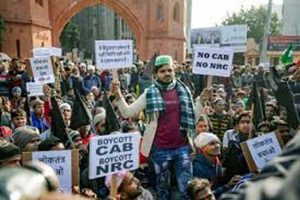 By Nageshwar Patnaik in Bhubaneswar, January 2, 2021: The year 2020 will go down for years as “The Worst Year Ever” as dubbed by Time Magazine. The Year saw COVID-19 pandemic leading the world to grind to a halt. This deadly coronavirus moved from one human to another without any contact; a cough, a sneeze, even just talking could transmit the virus.
By Nageshwar Patnaik in Bhubaneswar, January 2, 2021: The year 2020 will go down for years as “The Worst Year Ever” as dubbed by Time Magazine. The Year saw COVID-19 pandemic leading the world to grind to a halt. This deadly coronavirus moved from one human to another without any contact; a cough, a sneeze, even just talking could transmit the virus.
Covid-19 has killed more than 1,799,076 people across the globe and counting till date. And there are currently 82,421,447 confirmed cases in 218 countries and territories.
The deadly virus did not spare India too. Close to 1.5 lakh people have succumbed to COVID-19.
The pandemic continues to rage — daily infections and deaths are scaling fresh peaks in Europe, the U.S. is closing in on 20 million confirmed cases and 3.4 lakh deaths and in some countries in Latin America, cases have remained high and are rising
What is worse is that the World Health Organization experts have warned that even though the corona virus pandemic has been very severe, it is “not necessarily the big one”, and that the world will have to learn to live with Covid-19. Hence, the underlying problems and challenges that made 2020 feel like a horror story will roll along with us into the New Year.
Like other countries, India imposed lockdown that really brought home the horror of the situation. People frantically tried to get home from wherever they were. Migrant workers defied the lockdown and made a rush for home, some walking hundreds of miles, some dying before they reached home. And when the lockdown was lifted, people crawled out with exhausted bodies.
The world’s most stringent lockdown in our country wreaked havoc on the economy and precipitated a migrant crisis never seen since Independence. The Year also witnessed hunger, loss of millions of jobs, protests over the Citizenship Amendment Act and farm laws, riots, floods, thunderstorms and a sense of economic deprivation wrought by a tiny virus that took over the world.
Loss of economic growth, rising unemployment, growing impoverishment, a massive shutdown shock for small and medium businesses, decline in Goods and Services Tax (GST) collections, loss of business for corporate India were part of 2020 that saw many things go wrong on several fronts: public health, the handling of the pandemic, the well-being of the people, the economy, national security and communal harmony. There is a decline in the human development index and the latest data indicate worrying rise in child malnourishment.
Hunger continues to haunt India despite a healthy rate of growth and inequality in India is on rise. The Narendra Modi government painted a positive picture of the Covid crisis but its impact on the health and economic aspects of people’s lives was quite apparent
The Chinese invasion in Ladakh in May, which Modi publicly denied and the subsequent stand-off with China was another highlight of the year. Politically, the BJP continues to dominate, winning elections and expanding its footprint while the Opposition is at wits end to counter the dominance of the ruling party.
The BJP’s Hindutva agenda was carried forward by the UP government’s ‘love jihad’ or anti-conversion legislation, followed by the MP government’s similar legislation last week. One will not be surprised to see other BJP ruled states emulating UP and MP in near future.
 The year 2020 began with the discordant notes of the Shaheen Bagh protest against Citizenship (Amendment) Act (CAA). The protests exposed the weakening of the ethos of secularism. Politics around the protests exposed the extent to which mainstream party politics is being shaped by the Hindutva consensus and how deep Muslim anxieties now run. However, this anxiety is giving way to new forms of political expression, illustrated in the success of Asaduddin Owaisi’s All India Majlis-e-Ittehadul Muslimeen in the Bihar elections.
The year 2020 began with the discordant notes of the Shaheen Bagh protest against Citizenship (Amendment) Act (CAA). The protests exposed the weakening of the ethos of secularism. Politics around the protests exposed the extent to which mainstream party politics is being shaped by the Hindutva consensus and how deep Muslim anxieties now run. However, this anxiety is giving way to new forms of political expression, illustrated in the success of Asaduddin Owaisi’s All India Majlis-e-Ittehadul Muslimeen in the Bihar elections.
The quest for a secular political ethos will likely turn on whether these new sites of electoral competition will pry open an alternative politics or deepen exclusionary politics. This is the question that will shape India’s democratic future in 2021 and beyond.
In the second month of the year, there were shameful communal riots in Delhi. But the pandemic enabled the State to crush protests, use its coercive powers to intimidate citizens and deepen prejudice with “love jihad” laws. In the aftermath of the protests, CAA and National Register of Citizens have receded to the background.
The farmers’ agitation on Delhi’s borders is another defining image of India in 2020 and the stand-off with farmers on farm laws over the contentious laws continues. Agitating farmers have occupied highways, converting them into new sites of protest. Even today, thousands of farmers are protesting at the entrance of Delhi. The harshest winter for years has not been able to break their determination. The trust deficit between the government and these farmers has been on the rise.
The farmers’ protest may be geographically limited, but the ripples it has caused are international. This movement bean in Punjab, which was once the hotbed of the separatists who tried to play the card of local and parochial sentiments. The thorns that were sown at that time in the name of the language, water and culture troubled Indian democracy for a long time. If this conflict is allowed to prolong, then some unforeseen disaster cannot be ruled out particularly at a time when the borders with China are already disturbed.
A lot was lost in 2020, but not the hope to think that 2021 will be better. Indians need to resolve to be patient and persistent to repair all that was lost in 2020 and hope that India will fight back for dissent, democracy, facts and compassion.



Leave a Reply
Be the First to Comment!